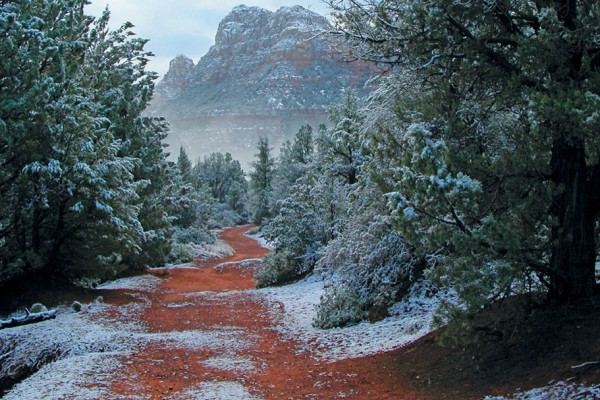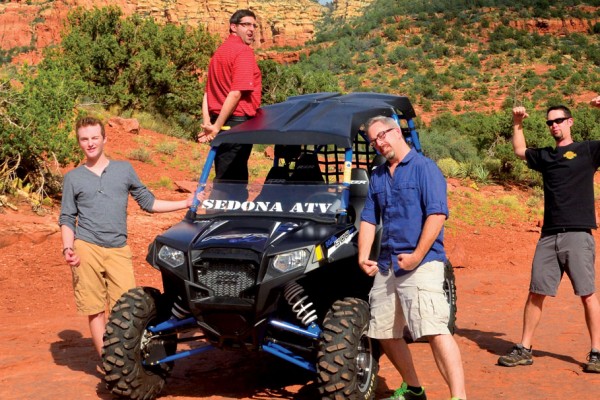Continued (page 2 of 2)
Back in the truck, Leon proceeded to tell us about the arrival of the Spanish in 1539 and the Pueblo Revolt of 1680. But it’s the story of Navajo Fortress Rock that really captured our hearts. In the winter of 1863, 300 Navajo living in Canyon del Muerto escaped Kit Carson’s troops by retreating to a 600-foot-tall monolith in the canyon. They used poles created from ponderosa pine trees to help them get to the top, babies strapped to cradle boards on their mothers’ backs. (With the help of binoculars, you can still see the original poles.) They spent three months living on 28 acres of land, forming a human chain to climb down the sheer rock walls in the middle of the night to collect water from the creek. Some Navajo didn’t make it, and Leon pointed to cracks in the rock where it’s believed their bodies are interred. The troops eventually gave up and left the area, but in the summer of 1864, the Navajo were rounded up and forced to walk 400 miles from Fort Defiance to Fort Sumner in New Mexico in what is known as the Long Walk.
Our last stop was White House Ruins, which are easily the most well-known ruins in the monument. The structure has been stabilized and reinforced (Leon says only 13 of the canyon’s 700 ruins have been stabilized). Though you aren’t able to enter the rooms, you can see the kiva (a round room used for religious ceremonies) and the log ladders leading to 10 upper rooms. From A.D. 1050 to 1250, White House included 60 rooms and housed 100 people. Today, Navajo vendors set up shop around the ruins while squirrels chase one another through the rooms. It is possible to hike to White House Ruins from the South Rim of the canyon. It’s the only trail in Canyon de Chelly that doesn’t require a permit or a Navajo guide. The trail is 1.25 miles one way and has an elevation change of 600 feet.
Sedona Monthly has been fortunate to spend a fair amount of time on the Navajo Reservation, but there’s something about Canyon de Chelly that makes it stand out as being different from other sites. For one thing, it served as a stronghold for the Navajo people for hundreds of years, and the canyon walls have witnessed some of the worst atrocities committed against Native Americans by European settlers. But as Leon points out, Canyon de Chelly’s story is still being written. “Unlike other attractions on the Navajo Nation, people still live here,” he says. “This is a true cultural experience.”
Canyon de Chelly Tours, 928-349-1600 or 928-349-1391; www.canyondechellytours.com. Tour rates begin at $75 per person, two-person minimum, in the off-season.
Where to Stay
There’s only one lodge inside Canyon de Chelly National Monument and that’s Sacred Canyon Lodge, which is owned by the National Park Service and managed by Shadi’i Co. and its three Ortega sisters. (There’s other lodging in nearby Chinle and a campground inside the park.) The Ortegas also own The View lodge in Monument Valley. Sacred Canyon was originally opened as a trading post in 1896. (The original trading post is now the lodge’s cafeteria-style restaurant.) The first motel rooms were built in the 1930s with additions in the ’60s and ’80s. Today, the quiet lodge includes 69 recently renovated rooms featuring flat-screen TVs and Native American art. The trading post, which was also remodeled after Shadi’i took over management, offers a striking selection of jewelry and Navajo rugs for sale.
Sacred Canyon Lodge, Rural Route 7 in Chinle (800-679-2473; www.sacredcanyonlodge.com)
MORE SEDONA ROAD TRIPS: Lake Powell, Havasu Canyon, photographing Arizona, 3 slot canyons, 10 places to go to beat the Arizona heat, Acoma Pueblo, Grand Canyon, The Wave, Oak Creek Canyon, Crown King, Jerome, Sunset Crater Volcano, Wupatki National Monument, Arizona animal parks, Monument Valley, Phoenix’s Musical Instrument Museum, Navajo National Monument, Mormon Lake



